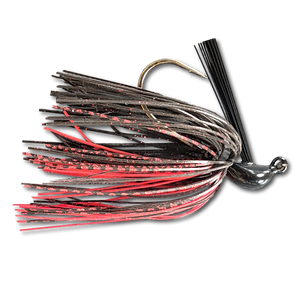Arky head jigs are named for their versatile, slightly flattened head shape that allows them to perform well in multiple scenarios. This design strikes a balance between flipping jigs and football jigs, making them suitable for fishing through heavy cover, rocky terrain, or open water.
The head’s shape helps the jig avoid snags while maintaining stability on the bottom, and it excels in situations where you need a single jig to handle varied conditions. Equipped with a skirt for added action and bulk, arky head jigs are a go-to option for anglers who value versatility.
Arky head jigs are incredibly adaptable, and their effectiveness comes from how they can be fished in multiple ways:
Flipping and Pitching: The weedless design and compact profile make arky head jigs ideal for flipping and pitching into heavy cover like brush piles, grass mats, and laydowns. Let the jig sink to the bottom, then use short hops or subtle shakes to mimic a crawfish or baitfish.
Dragging: The arky head’s stability allows it to be dragged along rocky bottoms or gravel bars without tipping over, making it perfect for targeting bass holding near ledges, points, or humps.
Swimming: Thanks to its balanced head design, arky head jigs can also be retrieved steadily through the water column. Pair them with a swimbait trailer for a lifelike baitfish imitation, especially near grass lines or shallow flats.
Skipping: The flat underside of the arky head makes it an excellent choice for skipping under docks or overhanging cover. The jig’s weight and profile allow for easy and accurate placement in hard-to-reach areas.
Stroking: In deeper water, lift and drop the jig off the bottom to create a darting, fleeing motion that mimics prey trying to escape. This technique works well for triggering reaction strikes.
Arky head jigs are versatile enough to be used year-round, but they excel in specific scenarios:
- Spring: During the pre-spawn, flip or pitch arky head jigs into shallow cover like grass edges or brush piles. Target spawning bass around docks or hard-bottom areas with a slow presentation.
- Summer: As bass move deeper, drag arky head jigs along ledges, points, or submerged brush piles. Swimming the jig through vegetation is also effective during warmer months.
- Fall: Arky head jigs mimic baitfish and crawfish during this season, making them ideal for fishing along shallow flats, riprap, or transition zones. Use a steady retrieve or skipping technique near cover.
- Winter: Slow down your presentation and fish arky head jigs near deeper structure like rocky points or submerged timber. Downsizing your trailer can also help tempt lethargic bass.
These jigs are effective in lakes, rivers, and reservoirs, particularly in areas with a mix of cover and structure. Their hybrid design makes them equally at home in heavy vegetation, rocky bottoms, or open water.
Best Colors and Trailers for Arky Head Jigs
Color selection for arky head jigs depends on water clarity and forage:
- Clear Water: Natural colors like green pumpkin, watermelon, and brown mimic crawfish or baitfish effectively.
- Stained or Murky Water: Brighter or high-contrast colors like black and blue, chartreuse, or white improve visibility.
- Low-Light Conditions: Darker colors like black or junebug create a strong silhouette for fish to key in on.
Pairing your arky head jig with the right trailer enhances its action and appeal:
- Craw Trailers: Perfect for flipping and pitching, these mimic crawfish with lifelike claw movements.
- Swimbait Trailers: Add a natural swimming motion when fishing jigs in open water or through grass.
- Chunk Trailers: Ideal for creating bulkier profiles in cold water or when targeting larger bass.
- Grub Trailers: Great for finesse or swimming presentations, especially in clear water.
Why Arky Head Jigs Are So Effective
Arky head jigs are a favorite among anglers because of their versatility and adaptability. Their hybrid head design allows them to excel in situations where other jigs might struggle, making them a reliable all-purpose option.
The combination of the jig’s profile, skirt, and trailer creates lifelike movement that triggers both feeding and reaction strikes. Whether you’re fishing heavy cover, rocky terrain, or open water, arky head jigs can handle the job.
Tips for Fishing Arky Head Jigs
- Use the Right Gear: A medium-heavy to heavy rod with fast action is ideal for fishing arky head jigs. Pair it with 15-20 lb fluorocarbon or braided line for maximum sensitivity and strength.
- Experiment with Retrieves: Adjust your retrieve to match the fish’s behavior. Slow drags and hops work well in cold water, while a steady swimming motion is effective in warmer conditions.
- Match the Hatch: Choose colors and trailers that closely resemble the forage in your area for the best results.
- Stay in Contact: Keeping the jig in contact with the bottom or structure is key to mimicking natural prey. Use a sensitive rod and line to detect subtle bites, especially in deeper water.
Arky head jigs are an essential tool for anglers who value versatility and performance. Their ability to handle a wide range of fishing situations makes them a reliable choice for targeting bass and other predatory fish. Whether you’re flipping into cover, dragging along rocky bottoms, or swimming through vegetation, arky head jigs are built to deliver. Stock up on your favorite colors and trailers, and let this all-purpose jig help you land more fish on your next trip.
Qwik Catches!







